英语人教版九年级全册Unit 11教学设计.教案
- 格式:doc
- 大小:116.50 KB
- 文档页数:19
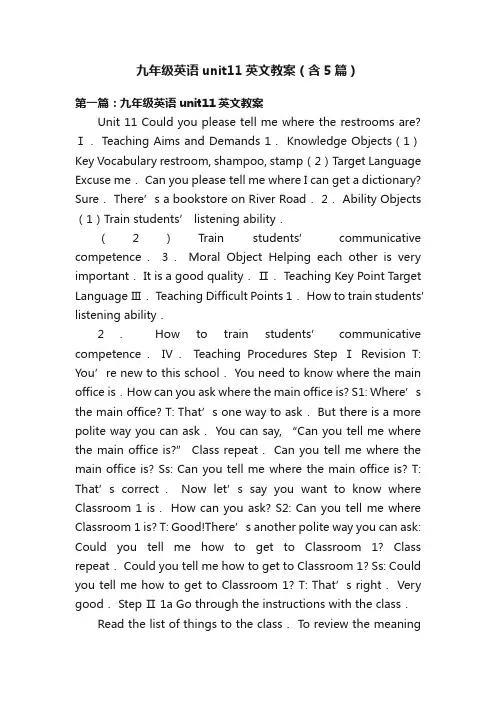
九年级英语unit11英文教案(含5篇)第一篇:九年级英语unit11英文教案Unit 11 Could you please tell me where the restrooms are? Ⅰ. Teaching Aims and Demands 1. Knowledge Objects(1)Key Vocabulary restroom, shampoo, stamp(2)Target Language Excuse me. Can you please tell me where I can get a dictionary? Sure.There’s a bookstore on River Road. 2. Ability Objects (1)Train students’ listening ability.(2)Train students’ communicative competence.3.Moral Object Helping each other is very important. It is a good quality.Ⅱ. Teaching Key Point Target Language Ⅲ. Teaching Difficult Points 1.How to train students’ listening ability.2.How to train students’ communicative competence.Ⅳ.Teaching Procedures Step Ⅰ Revision T: You’re new to this school. You need to know where the main office is.How can you ask where the main office is? S1: Where’s the main office? T: That’s one way to ask. But there is a more polite way you can ask.You can say, “Can you tell me where the main o ffice is?” Class repeat. Can you tell me where the main office is? Ss: Can you tell me where the main office is? T: That’s correct.Now let’s say you want to know where Classroom 1 is. How can you ask? S2: Can you tell me where Classroom 1 is? T: Good!Ther e’s another polite way you can ask: Could you tell me how to get to Classroom 1? Class repeat. Could you tell me how to get to Classroom 1? Ss: Could you tell me how to get to Classroom 1? T: That’s right. Very good.Step Ⅱ 1a Go through the instructions w ith the class.Read the list of things to the class. To review the meaningof each item on the list, invite different students to say each phrase in their own words.Point to the lettered parts of the picture one by one. Ask a student: What kind of place is this? What do they sell there? Do we have one in our community? What is the name of the one in our community? Point out the sample answer.Say, The letter c is in front of the words buy shampoo because you could buy shampoo in a department store.There may be more than one correct answer for some blanks.While students are working, move around the room offering help as necessary.Step Ⅲ 1b Read the instructions to students. Point out the two conversations that are shown in the picture. As you listen, fill in the blanks with words you hear in the recording. Play the recording the first time.Students only listen.Play the recording a second time.This time ask them to fill in the blanks with the words you hear. Check the answers with the whole class.Step Ⅳ 1c Read the instructions to the class.Point out the list of things people need and the pictures of the places in activity 1a.Say.Look at activity la.Have a conversation with a partner. Ask your parter politely where you can do theseThe First Period thi ng and then answer your partner’s questions.As students work, listen to some pairs in order to check the progress and help with pronunciation as needed.After students have had a chance to practise several exchanges, ask some pairs to come to the front of the classroom and act out their conversations.Step Ⅴ Homework Review the target language.Ⅰ. Teaching Aims and Demands 1. Knowledge Objects(1)Key Vocabulary escalator, furniture, exchange money, elevator(2)Target Language Excuse me.Do you know where I can exchange money? Sure.There’s a bank on the second floor. Take the escalator to the second floor and turn right. The bank is next to the bookstore.2.Ability Objects(1)Train students’ listening ability.(2)Train students’ communicative competence. 3. Moral Objects If someone asks you how to get to the place he wants to go to, you should tell him the way correctly.Ⅱ.Teaching Key Points 1.Key Vocabulary exchange money 2. Target Language Excuse me. Do you know where I can exchange money? Sure.There’s a bank on the second floor.3.Structures Do you know where I can buy shampoo? Could you tell me how to get to the post office? Can you please tell me where I can get a dictionary? Ⅲ. T eaching Difficult Points 1. Indirect questions.2.How to improve studen ts’ listening ability.Ⅳ.Teaching Procedures Step Ⅰ Revision Check homework.Step Ⅱ 2a Read the instructions and point to the list of directions.Get students to name the items in the picture such as escalator, elevator, shoe store, and so on.Play the recording. Students only listen.Tell them that the picture may help them understand what they are hearing.Play the recording again. This time ask students to write a number next to four of the directions.Check the answers with the whole class.Step Ⅲ 2b Point tothe picture. Say, now you will hear the recording again. This time show where the boy went as he followed the directions to the drug store. Draw a line on the picture in your book.Play the recording again and ask students to draw the line on their own. Check the answer with the class.Step Ⅳ 2c Ask a pair of students to read the sample conversation aloud to the class.Read the instructions aloud.Say.Make conversations using information about the places in the picture with your partners.As students work, move around the classroom checking the progress of the pairs and offering help as needed.The Second Period Ask one or two pairs to say their conversations to the class. Ask the rest of the class to look at the picture as they listen.Step Ⅴ Homework Ask the students to write three sentences with the starters of the structures.The Third Period Ⅰ.Teaching Aims and Demands 1.Knowledge Objects(1)Key Vocabulary hang out, fresh, advantage, disadvantage, block(2)Target Language Go out the front door and take a right. Walk about three blocks. Go past the park, and turn left onto Oak Street.3.Moral Objects Anything has both advantages and disadvantages.We should treat everything correctly.Ⅱ.Teaching Key Point Train students’ listening, speaking, reading and writing ability.Ⅲ.Teaching Difficult Points How to improve students’ integrating skills.Ⅳ.Teaching Procedures Step Ⅰ Revision T: Yesterday we learned the structures.Do you know where…? Could you tell me how to get to…? Can you ple ase tell me where…? Now who can make sentencesby using the structures? Step Ⅱ 3a Read the instructions. Point out the blank lines under the words Advantages and Disadvantages below the interview.You will write your answers in these blanks.Read the first two sentences at the top of the article.Explain that the interviewer will talk to several teenagers.Get students to read the interview on their own quickly.When they have finished, ask if there are any words or sentences they don’t understand. If there are, explain them.Ask students to read the interview again and write the advantages and disadvantages.Check the answers with the whole class.Step Ⅲ 3b Read the instructions. Point out the conversation in the box and invite two students to read it to the class.Point out the list of advantages and disadvantages in Activity 3a. Say, You can use these items and any other items you can think of as you talk about places you usually hang out.Ask students to work in groups of four or five. As they work, move around the classroom helping the groups as necessary.Make sure they talk about both advantages and disadvantages.Ask several groups to act out part of their conversation to the class.Step Ⅳ 4 Read the instructions to the class. Get students to look back at the picture and activities on the first page of this unit.Point out the sample language in the box. Invite a student to read it to the class.Ask students to say the names of some stores and other places in the community and write them on the board. Say, Each group can choose three of these places to write about, or you canchoose another place you know of Write careful directions from the school to each place, but do not say the name of the place. You can use the words this place instead. In order to help students work, draw a simple map showing the school and several nearby streets.When the groups are ready, they read their directions to the class and the other students guess the name of the place they are talking about.Step Ⅴ Homework 1. Ask students to choose two places in the community and write careful directions from the school to each place.2. Finish off the exercises on pages 46~47 of the workbook.Ⅰ. Teaching Aims and Demands 1. Knowledge Objects(1)Key Vocabulary fascinating, convenient, safe, restroom, inexpensive(2)Target Language Can you tell me where there’s a good place to eat? Of course. What kind of food do you like? 2.Ability Objects(1)Train students’ writing and speaking ability.(2)Train students’ ability to understand the target language in spoken conversation.(3)Train students’ ability to use the target language.Ⅱ. Teaching Key Points 1. Key Vocabulary convenient, safe, restroom inexpensive 2.Target Language Can you tell me where there’s a good place to eat? Of course. What kind of food do you like? Ⅲ. Teaching Difficult Points 1.How to improve students’ writing and speaking ability.2.How to use the target language.Ⅳ.Teaching Procedures Step Ⅰ Revision Check homework.Step Ⅱ 1a Go through the instructions with the class.Read the words in the box to the class and ask if there are any of these words that students don’t understand. If so, helpstudents to explain the meaning of the word.Then read the instructions again and point out the sample answer.Get a student to read the sample answer to the class. Point out that students can also write other words after the word clean. Ask students to write words from the box in the blanks on their own.Help students if needed.Correct the answers by having students read what qualities he or she listed.Step Ⅲ 1b Read the instructions to the class.Point out the example in the box.Invite two students to read it to the class.Now work with a partner.Look at the words in the box and use them to talk about places in your own city.As students talk, move around the classroom checking their work. Offer language support as needed.Invite several pairs of students to say their conversations to the class.Step Ⅳ 2a Point to the picture and ask students to tell what is happening. If necessary, explain that the scene shows a family on vacation.They are asking the man for information about various things to do in Sunville.Go through the instructions and point to the chart.Play the recording. Students only listen the first time.Play the recording again. Ask students to write the places people ask about.Check the answers with the whole class.Step Ⅴ 2b Read the instructions and point to the chart. You will hear the same recording again.This time listen carefully to the answers the cleck gives. Write the answers in the blanks alone.The Fourth Period Point out the sample answer.Play the recording again.Ask students to write their answers in the blanks. Check the answers.Step Ⅵ 2c Point to the sample conversation. Invite two students to read it to theclass. Read the instructions. Role play the conversations you hear on the tape.Get students to work in pairs.Move around the room checking the progress of the pairs and offering help as needed.Ask one or two pairs to say their conversations to the class.Step ⅦHomework Talk about some places using the words in la, then write down the conversations.Ⅰ. Teaching Aims and Demands 1. Knowledge Objects(1)Key Vocabulary water slide, clown, dress up, have fun(2)Practise reading an article.(3)Practise writing something using the target language.2.Ability Objects(1)Train students’ reading ability.(2)Train students’ writing ability.Ⅱ. Teaching Key Point Practise reading and writing using the target language.Ⅲ. Teaching Difficult Point How to write a guide to a place.Ⅳ.Teaching Procedures Step I Revision Review the target language presented in this unit. Check homework. Step Ⅱ 3a Invite a student to read the article aloud to the class. Correct any pronunciation errors to make sure the student is providing a good model for the rest of the class.Ask students to read the article again and complete the chart. Get students to do the work on their own or in pairs. As they work, move around the classroom and offer help as necessary. Check the answers. Step m 3b Read the instructions to the class. Point to the first two sentences and ask a student to read these sentences to the class.Look back at Activities 2a and 2b. Use this information to help you complete the guide to Sunville. Ask the students to complete the brochure on their own. As they work, walk around the classroom offering help and answering questions as needed.Invite a student to read the completed article to the class.Step Ⅳ 3c Read the instructions to the class.Ask students to say the names of some of the places they might write about. Write a list of these places on the board for students to use as they write their guides.Ask students to work on their own. Tell them that they can use what they wrote for activity 3b as a guide. They can write the guide for all tourists, teenagers, families, or people on a budget. As they work, move around the room offering help as needed.Correct the students’ work. Ask some students to read their guides and correct them.Step Ⅴ Part 4 G o through the instructions with the class.Get students to look back at the guides they wrote in Activity 3c.Ask students to work in groups of four or five students. Let different students play the role of the booth worker and the different tourists.Make sure every student has a chance to participate.Ask one or two groups to say one of their conversations to the class.The Fifth Period Step Ⅵ Homework 1. Read the article in 3a again. 2. Write a guide to our city.Ⅰ. Teaching Aims and Demands 1. Knowledge Objects(1)Fill in blanks and make sentences using beautiful, safe, delicious, convenient, fascinating.(2)Write some questions using the target language.2.Ability Objects Train students’ writing ability.Ⅱ.Teaching Key Points 1.Fill in blanks and make sentences.2.Write questions using the target language.Ⅲ. Teaching Difficult Point Make sentences using “beautiful, safe, delicious, convenient,fascinating”.Ⅳ.Teaching Procedures Step Ⅰ Revision Check homework. Ask a few students to read the article in 3a. Then ask a few students to read their guides.Step Ⅱ Part 1 Look at the words in the box. Ask a student to read them. Make sure the students understand the meaning of the words. You are to fill in the blanks with the words. In some cases, students may need to use another form of the word, for example adjusting for tense or subject/ verb agreement.Ask students to fill in the blanks on their own. Check the answers.Step ⅢPart 2 Go through the instructions with the class.Look at the example with the students.Ask students what the answer would be.Ask a student to read the question and answer it.Excuse me, could you tell me where the bank is, please? The bank is across the street from the shopping malt. Get students to complete the work in pairs.Check the answers.Ask a few students to read their questions.Step Ⅳ Just for Fun!Ask all the students to read the conversation.Ask: What is funny about this cartoon? Help students to explain. A Martian is a person from the planet Mars.There is no such thing as Martian food on Earth, and the clerk looks silly because he is trying to think of where there is a Martian restaurant.Invite some pairs of students to present this conversation to the rest of the class.Step Ⅴ Summary and Homework In this class, we’ve done much writing practice using the key vocabulary words and the target language presented in this unit. After class, please finish the questions in 2 in your exercise books.Then finish the exercises on pages 47~48 of the workbook as well.The Sixth PeriodThe Seventh PeriodⅠ Teaching Aims and Demands 1. Knowledge Objects(1)Key Vocabulary image, adventure, jealousy, hero, crime, journey, brave, no longer, show interest in, take it easy, become interested in, plain looks(2)Text: Grown-ups like cartoons, too. 2. Ability Objects(1)Fast-reading to get a general idea of the text.(2)Careful-reading to get the detailed information in the text.(3)Learn the words and phrases from the context.Ⅱ. Teaching Key Points 1. Key vocabulary.2.Train students’ reading a nd writing skills.Ⅲ.Teaching Difficult Point Train students’ reading and writing skills.Ⅳ. Teaching Procedures Step I Key Vocabulary Say the words and have students repeat them again and again until they can pronounce them fluently and accurately. Step Ⅱ Part 1 Read the title Grown-ups like cartoons, too.To the class. Ask, what do you think the article is about? Look at the picture.Ask students to describe what is happening in the picture. Ask students to answer the five questions.But don’t look at the reading text.Instead, they use their background knowledge to try to answer the questions. As students work, walk around, looking at their progress.When most students finish the task, ask students to answer the questions with a parter.Elicit answers from the students. Ask if other students have the same or different answers. Do not give the correct answers to the students at this point. Wait until students have finished the reading and let them revise their answers accordingly. StepⅢ Part 2 Read the te xt quickly, then summarize each paragraph in your own words. As the students are doing this, move around the classroom to make sure they can do the task in English. Ask five students to report their answers.Draw students’ attention to the instructions.Ask students to complete the task individually or in pairs.As they work, walk around the classroom to make sure students discuss their reasons in English. Have students report their answers.Encourage students to use complete sentences.Step Ⅳ Part 3 Point to the story. Look at the words indicated in bold.Ask different students to guess the meaning.Don’t give them the correct answers. Ask students to read the article once. Say, pay attention to the bold words and expressions. And note any other words or sentences, you don’t understand. Read in context, guessing their meanings from the other words around them. Ask students to read the article again for comprehension.Read the instructions with the students and have them look at the example.Then ask students to match the correct meanings with the correct words and expressions. Allow them one or two minutes to do this.Check the answers: Get students to make sentences with the words and expressions. Remind them to look at the article again for extra help.Answers to this activity will vary.Then ask a students to write his/her answers on the blackboard.Help correct any mistakes.Step Ⅴ Part 4 Read the instructions to the class. Elicit the first answer from the students from memory.Make sure that they understand what they need to do.Ask students to do the activity on their own or in pairs. Asthey work, walk around the classroom offering help students may need. Check the answers.Step Ⅵ Part 5 Read the task with the students.Ask students to do the activity in small groups. Try to put creative and artistic students in each group. Check the answers and have students show or act out their cartoons for the class. Optional activityAs an optional in-class or homework activity, remind students to find some cartoons and cut out the speech bubbles.Students can then write their own English stories in the speech bubbles.Step Ⅶ Homework 1.Read the story in 2 again for further comprehension.2.Revise the target language in this unit.第二篇:九年级英语unit 15教案雨龙中学高效课堂(二次备课)导学案课题:Unit 15 We’re trying to save the manatees!备课组:英语主备教师:杨翠芳授课时间:3.8—3.12授课班级:82,83,84备课组长审核签字:【预习导学——不看不讲】一、明确目标:1.学会区分并正确使用“一般现在时,现在进行时,现在完成时,to + 动词原形,被动语态”;2.阅读3a与3b,并按要求完成课后练习;3.掌握课文中出现的重点词组;4.保护动物,人人有责;二、自主学习:1.翻译GF部分,并区分相应语法和时态;2.翻译词组:(1)反对做某事;(2)适合;(3)对…感到吃惊;(4)活生生的教科书;(5)为某人提供某物;(6)关心、照顾;(7)同意;(8)不同意;三、检查释疑:各小组中对子相互检查自主学习部分,并说说不同答案的理由;【合作探究——不议不讲】一、合作学习: 2.Read a letter to the editor in 3b and give your opinion.3.Debate二、探究展示:各小组对子相互检查合作学习部分的答案,对疑问点提出自己的意见;【导学测评——不练不讲】一、导学测评(一)基础题——初显身手同步解析与测评:单项选择4,5, 8, 9 ;(二)能力题——挑战自我译一译:1.我不同意你的观点,我认为动物园是动物生活的好地方。

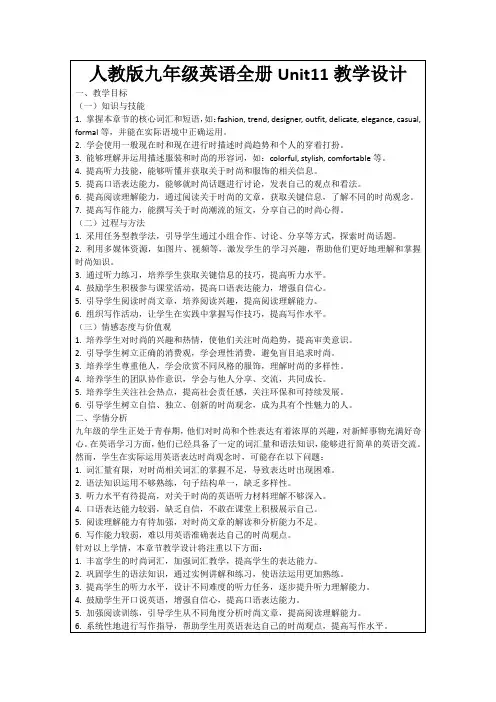
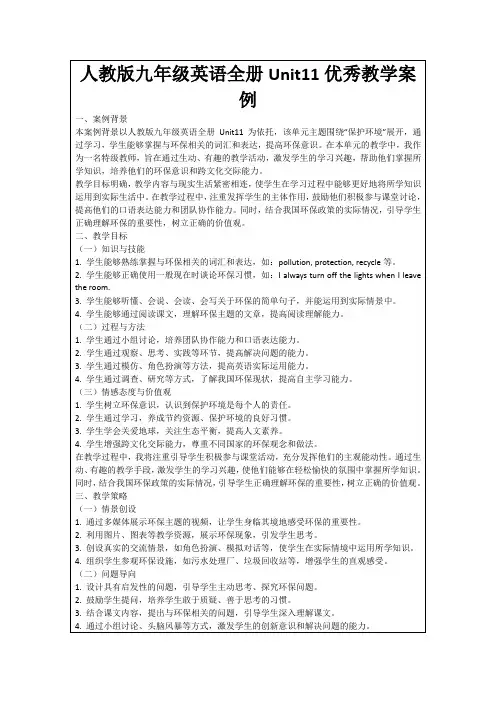
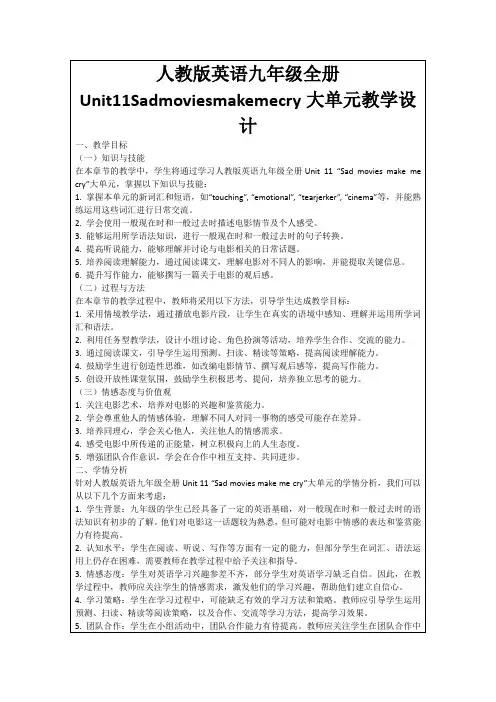
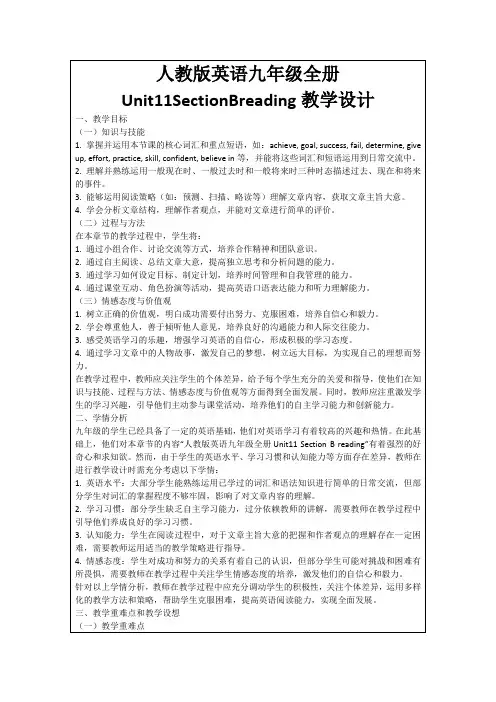

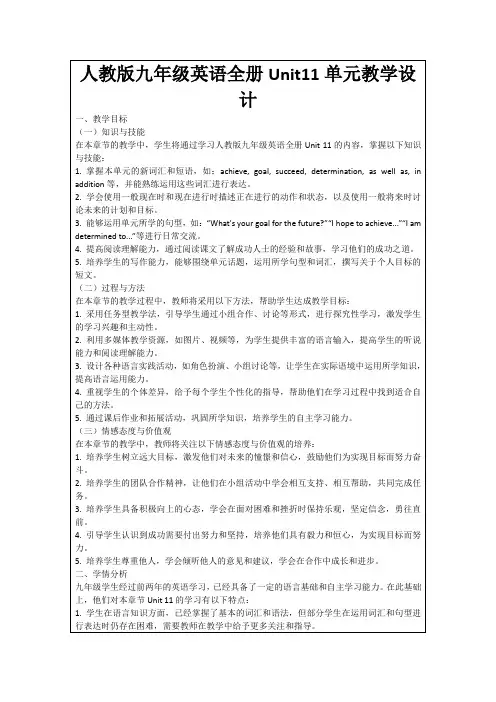
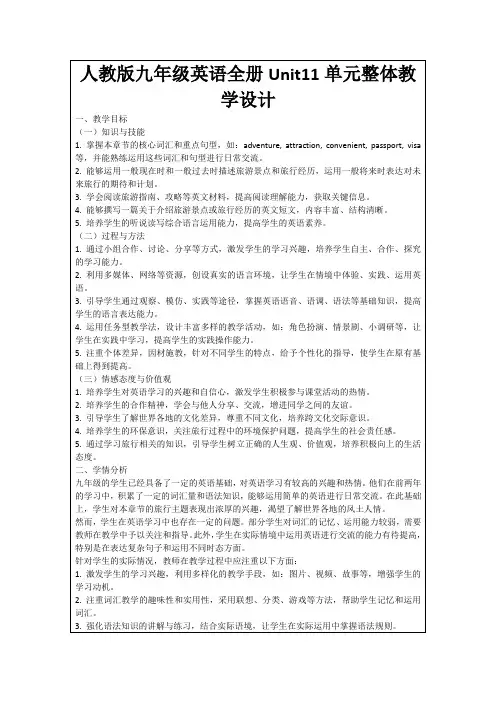
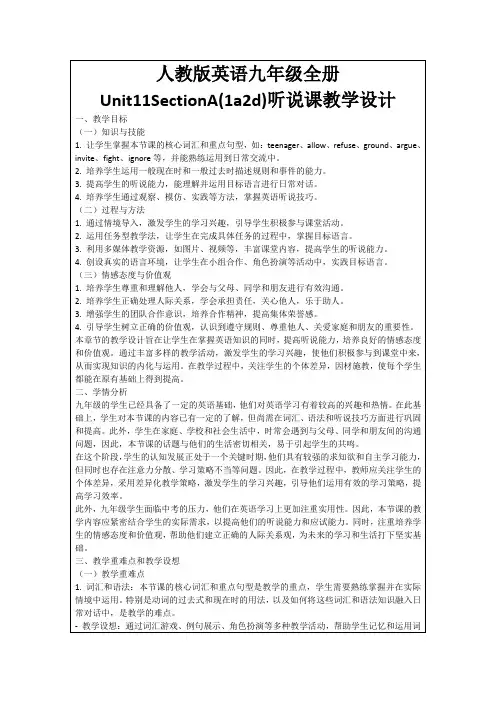

英语⼈教版九年级全册Unit11教学设计.教案Unit 11 Sad movies make me cry.⼀、教学⽬标:1. 语⾔知识⽬标:单词:friendship 友谊, king 君主, pale 苍⽩的, queen 王后, examine 检查, nor 也不, palace 王宫, power 权⼒, wealth 财富, grey 阴沉的, lemon 柠檬, fame 名声, Prime ⾸相的句型:The loud music makes me nervous.Soft and quiet music makes me relaxed.Money and fame don’t always make people happy.She said that the sad movie made her feel like crying.能够⽤英语描述事情对⾃⼰感情的影响,复习被动语态。
2.情感态度价值观⽬标:了解⼀些表达感情的词,能正确的表达⾃⼰的感情,并培养学⽣正确处理事情,特别是不好的事情对⾃⼰的正⾯影响。
⼆、教学重难点1. 教学重点:1) 掌握本课时中出现的⽣词2) 能够⽤英语描述⾃⼰的情感。
3)正确理解make 的⽤法。
2. 教学难点:掌握make的⽤法Section A 1 (1a-2d)I. Leading in: Kinds of moviesReview the kinds of movies and answer the question “How do you feel about the movie?”II. Learning1. 1a. Look at the two restaurants below. Which would you like to go to? Why?2.1b.Listen and fill in the blanks. Then match the restaurants with the statements.3. 1c.Role-play a conversation between Amy and Tina.Tina: I’d rather go to Blue Ocean because I like to listen to quiet music while I’m eating.Amy:But that music makes me sleepy. I want to have the hamburgers at Rockin’ Restaurant.Tina:Let’s go to the Rockin’ Restaurant. I love their hamburgers.Amy:Those awful pictures on the walls make me uncomfortable, and the loud music makes me nervous.Tina: So where do you want to go, Amy?Amy: Let’s go to Blue Ocean. The soft music makes me relaxed.4. 2a. Listen and number the picture (1-4) in the order you hear them.5. Listen again. Complete the statements.1. Waiting for Amy drove Tina__________ (crazy).2. Amy said loud music made her__________ (nervous).3. Loud music makes John_____________. (want to dance)4. T e movie was so sad that it made Tina______. (cry)5. Sad movies don’t make John cry. They just make him______________ (want toleave).6. Role-play the conversation.7. 2d Pole-play the conversation.Nancy: Hey Bert, I think I’ve made Alice mad and I’m not sure what to do about it. Bert: What happened?Nancy: You know Julie is Alice’s best friend, right?Bert: Uh-huh.Nancy: Well, the more I got to know Julie, the more I’ve realized that we have a lot in common. So we’ve been spending more time together lately.Bert: But what’s wrong with that?Nancy: Umm ... it makes Alice unhappy because she thinks Julie is now bet her friends with me than with her.Bert: I see. Mmm ... why don’t you ask Alice to join you each time you dosomething with Julie? Then she won’t feel left out.Nancy: Oh, good idea! That can make our friendship stronger.III. Language points.1. I’d rather go to the Blue Ocean Restaurant because I like to listen toquiet music while I’m eating.would rather do sth.,意为“宁可,宁愿还是……好些”。
Unit 11 Sad movies make me cry.一、教学目标:1. 语言知识目标:单词:friendship 友谊, king 君主, pale 苍白的, queen 王后, examine 检查, nor 也不, palace 王宫, power 权力, wealth 财富, grey 阴沉的, lemon 柠檬, fame 名声, Prime 首相的句型:The loud music makes me nervous.Soft and quiet music makes me relaxed.Money and fame don’t always make people happy.She said that the sad movie made her feel like crying.能够用英语描述事情对自己感情的影响,复习被动语态。
2.情感态度价值观目标:了解一些表达感情的词,能正确的表达自己的感情,并培养学生正确处理事情,特别是不好的事情对自己的正面影响。
二、教学重难点1. 教学重点:1) 掌握本课时中出现的生词2) 能够用英语描述自己的情感。
3)正确理解make 的用法。
2. 教学难点:掌握make的用法Section A 1 (1a-2d)I. Leading in: Kinds of moviesReview the kinds of movies and answer the question “How do you feel about the movie?”II. Learning1. 1a. Look at the two restaurants below. Which would you like to go to? Why?2.1b.Listen and fill in the blanks. Then match the restaurants with the statements.3. 1c.Role-play a conversation between Amy and Tina.Tina: I’d rather go to Blue Ocean because I like to listen to quiet music while I’m eating.Amy:But that music makes me sleepy. I want to have the hamburgers at Rockin’ Restaurant.Tina:Let’s go to the Rockin’ Restaurant. I love their hamburgers.Amy:Those awful pictures on the walls make me uncomfortable, and the loud music makes me nervous.Tina: So where do you want to go, Amy?Amy: Let’s go to Blue Ocean. The soft music makes me relaxed.4. 2a. Listen and number the picture (1-4) in the order you hear them.5. Listen again. Complete the statements.1. Waiting for Amy drove Tina__________ (crazy).2. Amy said loud music made her__________ (nervous).3. Loud music makes John_____________. (want to dance)4. T e movie was so sad that it made Tina______. (cry)5. Sad movies don’t make John cry. They just make him______________ (want toleave).6. Role-play the conversation.7. 2d Pole-play the conversation.Nancy: Hey Bert, I think I’ve made Alice mad and I’m not sure what to do about it. Bert: What happened?Nancy: You know Julie is Alice’s best friend, right?Bert: Uh-huh.Nancy: Well, the more I got to know Julie, the more I’ve realized that we have a lot in common. So we’ve been spending more time together lately.Bert: But what’s wrong with that?Nancy: Umm ... it makes Alice unhappy because she thinks Julie is now bet her friends with me than with her.Bert: I see. Mmm ... why don’t you ask Alice to join you each time you dosomething with Julie? Then she won’t feel left out.Nancy: Oh, good idea! That can make our friendship stronger.III. Language points.1. I’d rather go to the Blue Ocean Restaurant because I like to listen toquiet music while I’m eating.would rather do sth.,意为“宁可,宁愿还是……好些”。
e.g. I’d rather play tennis than swim.比起游泳我宁愿去打台球。
2. Yes, she was, and waiting for her drove me crazy.drive v.迫使drive sb.+adj.,使某人怎样drive sb. crazy/mad 使某人发疯/发狂e.g. That thing almost drive me crazy. 那件事几乎要使我发狂了。
You’ll drive mum mad one of these days.你这样总有一天会把妈妈急疯了的。
3. What happened?happen 发生,不及物动词,常见的用法有(1) “sth.+happen+地点/时间”,“某地/某时发生了某事”e.g. What’s happening outside? 外面发生什么事了?(2) “sth.+happen to+sb.” 意为“某人出了某事(常指不好的事发生在某人身上)”。
e.g. A car accident happened to him yesterday. 昨天他发生了交通事故。
(3) “sb.+happen+to do sth.” 意为“某人碰巧做某事”e.g. I happened to meet her in the street.我碰巧在街上遇见她。
4. Th e more I got to know Julie, the more I’ve realized that we have a lot in common.the+比较级+从句,the +比较级+从句“越……, 越……”e.g. The harder you work, the greater progress you will make.你越用功,进步就越大。
5. Why don’t you ask Alice to join you each time yo u do something with Julie?Why don’t +sb.+do sth.?=Why not + do sth.? 为何不……?用来提出建议或劝告。
e.g. Why don’t you go with us?Why not go with us? 你为什么不和我们一起去呢?6. Then she won’t feel left out.to be/feel left out 表示“被遗忘;被忽略;被冷落”之类的意思。
e.g. No one speaks to him, he always feels left out.没人跟他讲话,他总是觉得被人冷落。
IV. Homework1.Recite the conversation in 2d.2. 翻译下列句子1)一直等她让我很生气。
2)愿待在家里也不愿去公园。
3)为什么不去看电影呢?4)汶川在2008年发生了一场大地震。
5)我们在一起越多,我们就越开心。
Section A 2 (3a-3c)I. Review1) 一直等她让我很生气。
2) 我宁愿待在家里也不愿去公园。
3) 为什么不去看电影呢?4) 汶川在2008年发生了一场大地震。
5) 我们在一起越多,我们就越开心。
Keys: Waiting for her drove me angry.I’d rather stay at home than go to the park.Why don’t you/not go to the movies?A big earthquake happened in Wenchuan in 2008.The more we get together, the happier we are.II. Free talkWhat can make you happy?III.Reading1. 3a Read the story and answer the questions.1) Can medicine help the ill king? Why or why not?2) Why does power not make the prime minister happy?3) Why does money not make the banker happy?4) Why does fame not make the singer happy?Keys: No. The doctor says there is nothing was wrong with his body.He’s always worried about losing his power. Many people are trying to take his position.He’s always worried about losing his money. Someone tries to steal his money every day.”He’s always worried about being followe d by others, so he cannot be free!2. 3b Find words or phrases from the story with meanings similar to thesephrases.1) did not want to eat _________________2) was asked to come and help ________________3) look carefully at __________________4) becoming less important ___________________5) get my job __________________Keys: didn’t feel like eatingbe called inexaminel osing … powertake my position3. 3c Role-play the story with your group.King:I’m unhappy. I sleep badly and don’t feel like eating.Doctor:It’s all in his mind. Neither medicine nor rest can help him. What he needs is the shirt of a happy person to we ar. That’ll make him happy.Prime Minister:Although I have a lot of power, it doesn’t make me happy. I’malways worried about losing my power. Many people are trying totake my position.Banker:Oh, I’m afraid I’m not happy either, I have a lot of wealth,but I’m always worried about losing my money. Someone tries to steal my money everyday.Singer:It’s true that I’m famous and everyone loves my songs. But I’m not happy because I’m always worried about being followed by others. I cannot be free! IV. Language points.1. He slept badly and didn’t feel like eating.他的睡眠很糟糕,他也不想吃东西。